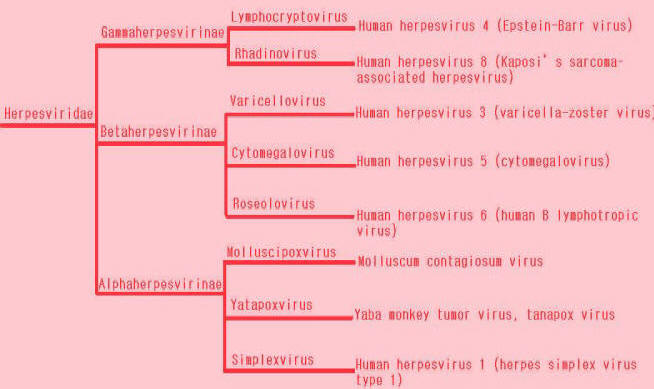While organisms that are currently defined as "living" are classified according to Kingdom, Phylum, Class, Order, Family, Genus, and Species, viruses begin their classification at Order. According to the ICTV (International Committee on Taxonomy of Viruses), viruses are classified according to phenotypic characteristics such as: nucleic acid type, whether that type of nucleic acid is single or double stranded, and the absence or presence of a envelope. Some classifications also take host cells and host organisms into effect. The Epstein-Barr virus is classified according to the following:
Order:
Herpesvirales-
Herpesvirales is a brand new order that contains all herpesviruses. ICTV just classified three families under this new order, including breaking down the Herpesviridae family into two other families. This order organizes all herpesviruses into one category making it easy to see evolutionary paths and relatedness of two or more viruses.
Family:
Herpesviridae-
A family consisting of double-stranded, linear, DNA viruses that are enveloped and can occur in a wide variety of vertebrate animals, including humans. Members of this family have large latency rates for the pathology induced, and are around 200 nanometers in length. This family of viruses is passed from host to host by means of contact.
Subfamily:
Gammaherpesvirinae-
A subfamily in which there are high latency rates for infection induced. Members of this subfamily are specific to either T-lymphocytes or B-lymphocytes and typically attack lymphoid tissues in vertebrates.
Genus:
Lymphocryptovirus-
A genus of viruses that only infects cells in humans and new world monkeys.
Species:
Human Herpesvirus 4-
A species of virus that infects humans only and causes infectious mononucleosis.
The phylogenetic tree below offers a view of the taxonomy explained above. As the order Herpesvirales is quite large and in depth, the table was cut to show only the family (Herpesviridae) to the various species were included. The species grouping of the Epstein-Barr virus has several strains, but as stated this site focuses only on the Human Herpesvirus 4 type.
Looking at the phylogenetic tree in more detail gives a good overview of how the various species and genuses are related. Starting the family Herpesviridae, we can say that anything grouped under this category is a virus that infects vertebrates only, and generally has a latent phase.
The subfamilies are broken down into host cell specifications. The Gammaherpesvirinae subfamily follows the evolution of the Epstein-Barr virus and only contains viruses that attack B cells. The subfamily Betaherpesvirinae infects leukocytes and the Alphaherpesvirinae infects only nuerons.
Continuing to the Genus branches we see more groupings based on host organism specialization. In turn each genus is broken down to include one of the eight known herpesviruses. These eight viruses infect only humans and a few primates as in the Yatapoxvirus genus. Looking at the taxonomy and phylogenetic tree of these different viruses we can see the species are all related through host specification and are then broken down more specifically into what pathologies and host cells they infect. The Epstein-Barr viruses closest relatives would be any of the Rhadinoviruses, as they are of the same genus.
Need to get to the top of the page, click here!


